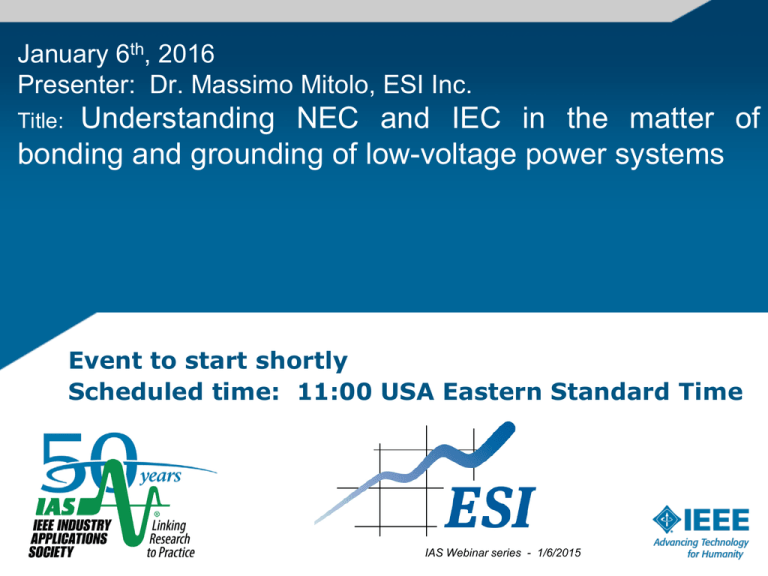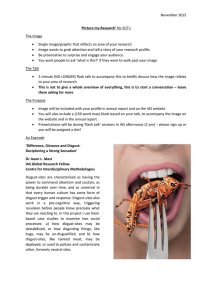
January 6th, 2016
Presenter: Dr. Massimo Mitolo, ESI Inc.
Understanding NEC and IEC in the matter of
bonding and grounding of low-voltage power systems
Title:
Event to start shortly
Scheduled time: 11:00 USA Eastern Standard Time
IAS Webinar series - 1/6/2015
1
IAS Webinar Series
Webinar Presenter: Dr. Massimo Mitolo
Massimo Mitolo, Ph.D., P.E., P. Eng.
Ph.D. in Electrical Engineering from the University of Napoli
“Federico II,” Napoli, Italy
Prominent Lecturer of IAS
Authored over 75 journal papers
Two books:
1. Electrical Safety of Low-Voltage Systems (McGrawHill, 2009)
2. Laboratory Manual for Introduction to Electronics: A
Basic Approach (Pearson Prentice-Hall, 2013)
Registered Professional Engineer in California and Italy
Currently working as a senior consultant with Engineering
Systems Inc. (ESI) in Foothill Ranch, CA, USA
Area of expertise includes electrical safety engineering, and
the analysis and grounding of power systems
Active within the Industrial and Commercial Power Systems
Department of IAS, as Department Secretary, Chair of the
Power Systems Analysis Subcommittee, and Chair of the
Grounding Subcommittee
2
IAS Webinar Series
Outline
Identify key concepts in the NEC for bonding and
grounding
Clarify the terminology used by IEC standards, with
regards to the protection against indirect contact in ac
(50/60 Hz) systems by automatic disconnection of
supply.
Examine types of grounding systems
Examine “Bonding”
Compare the EGCs/PE Conductor sizing procedures in
IEC and NEC
Discuss key technical concepts present in the IEC
world regarding “bonding”
3
3
IAS Webinar Series
NEC Art. 90.1 (1)
Purpose.
(A)Practical Safeguarding. The purpose of this Code is the
practical safeguarding of persons and property from
hazards arising from the use of electricity.
(B)Adequacy. This Code contains provisions that are
considered necessary for safety. Compliance therewith and
proper maintenance results in an installation that is
essentially free from hazard but not necessarily efficient,
convenient, or adequate for good service or future
expansion of electrical use.
4
IAS Webinar Series
NEC Art. 90.1(2)
The requirements in this Code address the fundamental principles of
protection for safety contained in Section 131 of IEC 60364-1,
Electrical Installation of Buildings:
≡
5
IAS Webinar Series
NEC Art. 250.4(3)
Bonding of Electrical Equipment.
Normally noncurrent-carrying conductive materials enclosing
electrical conductors or equipment, or forming part of such
equipment, shall be connected together and to the electrical
supply source in a manner that establishes an effective ground
fault current path.
6
IAS Webinar Series
NEC Art. 250.4(4)
Bonding of Electrically Conductive Materials and
Other Equipment
Normally non-current-carrying electrically conductive
materials that are likely to become energized shall be
connected together and to the electrical supply source in a
manner that establishes an effective ground fault current path.
7
IAS Webinar Series
IEC 60364-1 Definitions (1)
Exposed-Conductive-Parts (ECP): conductive elements,
forming part of the electrical system, which can be touched
(even if out of reach) and is not live, but likely to become
live when basic insulation fails.
8
IAS Webinar Series
IEC 60364-1 Definitions (2)
A conductive part of electrical equipment, which can
only become live through contact with an ECP, which
has become live, is not considered an ECP by IEC.
Bonding the
drawers?
9
IAS Webinar Series
IEC 60364-1 Definitions (3)
direct contact: contacts with parts normally live (e.g.
a damaged wire)
indirect contact: contacts with metal parts normally
not energized, but likely to become live upon faults
(e.g. faulty equipment).
Protections against direct and indirect contact are also
respectively referred to as basic and fault protections.
10
IAS Webinar Series
IEC 60364-1 Definitions (4)
Both IEC and NEC prescribe that ECPs shall:
be connected to the same earthing system individually, in
groups or collectively, via a protective conductor (PE).
be connected to earth, together and to the electrical
supply source via an equipment grounding conductor.
IEEE Standard P3003.2 "Recommended Practice for Equipment Grounding and Bonding in
Industrial and Commercial Power Systems”; August 2014.
11
IAS Webinar Series
IEC 60364-1 Definitions (5)
Extraneous-Conductive-Parts
(EXCP):
conductive
elements, not forming part of the electrical system, liable to
introduce a “zero” potential or an arbitrary potential.
12
IAS Webinar Series
continued EXCP
Jamb non-intentionally grounded if in
contact with re-bars.
??
13
IAS Webinar Series
continued EXCP
Totem: one that serves as an emblem or revered symbol
IAS Webinar Series
14
NEC Grounding Electrode (1)
NEC defines the IEC EXCPs as non-intentional ground
electrodes within the facility, such as:
metal underground water pipe
metal frame of the building (if effectively grounded)
reinforcing bars in concrete foundations.
“[…] All the grounding electrodes present in a building
must be bonded together to form a grounding electrode
system.”
15
IAS Webinar Series
Grounding Electrode (2)
NEC Article 250.68 (B): [...] Where necessary to ensure the
grounding path for a metal piping system used as a
grounding electrode, bonding shall be provided around insulated
joints and around any equipment likely to be disconnected for repairs or
replacement […].
16
IAS Webinar Series
Grounding Electrode (3)
Both IEC and NEC do not permit the metal gas pipe to be an earth electrode.
However:
IEC does require always the bonding of gas pipes (load side of meter).
NEC does require the bonding of gas pipes installed in buildings only if they are
likely to become energized (250.104(B)).
17
IAS Webinar Series
Ground electrode (3)
IEC 60364-5-54 does not permit water pipes to be relied
upon as earth electrodes, even with the consent of the water
distributor, being questionable their metallic continuity in
time;
both NEC and IEC 60364-5-54 concur that metallic pipes
employed for flammable liquids or gases must not be used as
an earth electrode.
However, as per IEC 60364-5-54 this requirement does not
preclude the protective bonding connection of such pipes
on the load side of the meter.
IEC 60364-5-54 “Electrical installations of buildings –Part 5-54: “Selection and erection of electrical
equipment – Earthing arrangements, protective conductors and protective bonding conductors”:
18
IAS Webinar Series
World Grounding Map
Unknown
19
IAS Webinar Series
TT (Terre – Terre) Systems
Algeria, Belgium, Denmark, Egypt, France, Greece, Italy,
Japan, Kenya, Luxemburg, Morocco, Tunisia, Spain,
Portugal, Turkey, United Arab Emirates, etc. 20
IAS Webinar Series
TT System (1)
L1
L2
L3
N
R
N
PE
System Grounding
R
ECP
G
ECPs are connected to earth independently of the ground electrodes of the
source.
The ground-fault current IG returns to the source through the actual earth.
21
IAS Webinar Series
TT System (2)
Overcurrent devices can protect against indirect contact only if the
following condition is fulfilled:
L1
L2
L3
N
R
IG =
N
PE
System Grounding
R
V ph
Z Loop
≥ Ia
ECP
G
ZLoop= summation of fault-loop impedances of the source + the line conductor up to the
point of the fault + the user’s ground RG + the utility ground RN.
Ia is the current that causes the tripping of the over-current protective device within the safe
time specified in the following Table (applicable to final/branch circuits not exceeding 32
A)
22
IAS Webinar Series
TT System (3)
Voltage (V)
Maximum disconnection times
ta (s)
50 < Vph ≤ 120
0.3
120 < Vph ≤ 230
0.2
230 < Vph ≤ 400
0.07
Vph > 400
0.04
23
IAS Webinar Series
TT System (4)
In practice, the previous condition is very difficult to fulfill, as
generally, ZLoop is not a sufficiently low value.
Residual Current Devices (RCDs) (also referred to as Ground Fault
Circuit Interrupters (GFCIs) in the NEC) must be employed.
RG∙Idn ≤ 50 V
Idn is the rated residual operating current of the RCD in amperes,
providing supply disconnection in the time specified in the previous
Table.
24
IAS Webinar Series
TT System (5)
NEC Art. 250.4(5)
Effective Ground-Fault Current Path
(5). Electrical equipment and wiring and other electrically
conductive material likely to become energized shall be
installed in a manner that creates a low-impedance circuit
facilitating the operation of the overcurrent device or
ground detector for high-impedance grounded systems. It
shall be capable of safely carrying the maximum groundfault current likely to be imposed on it from any point on
the wiring system where a ground fault may occur to the
electrical supply source. The earth shall not be
considered as an effective ground-fault current path
25
IAS Webinar Series
TN (Terre – Neutral) Systems
Australia, Canada, Germany, South Africa, Sweden,
Switzerland, the UK, USA, etc.
26
IAS Webinar Series
TN System (1)
L1
L2
L3
PEN
N
PE
R
N
ECP
ECP
ECPs are directly connected to the solidly grounded point of
the source.
27
IAS Webinar Series
TN System (2)
Protective devices (i.e. overcurrent/RCD) can protect against indirect
contact only if the following condition is fulfilled:
ZLoop∙Ia ≤ Vph
L1
L2
L3
N
PE
R
N
ECP
System Grounding
ZLoop= summation of fault-loop impedances of the source + the line conductor up to the
point of the fault + the protective conductor between the point of the fault and the source.
Ia is the current that causes the tripping of the over-current protective device within the safe
time specified in the following Table:
28
IAS Webinar Series
TN System (3)
Voltage (V)
Maximum disconnection times ta (s)
50 < Vph ≤ 120
0.8
120 < Vph ≤ 230
0.4
230 < Vph ≤ 400
0.2
Vph > 400
0.1
29
IAS Webinar Series
IT (Isolation -Terre) Systems
Norway; Albania; Iran; Iraq; Peru; critical facilities
30
IAS Webinar Series
IT System (1)
Excerpted from: M. Mitolo “Electrical Safety of Low-Voltage Systems”, McGraw-Hill, 2009
The capacitive current, although relatively small (i.e., tens of
amperes), is large enough to be lethal to persons. To avoid this
hazard, the ECPs shall be grounded.
31
IAS Webinar Series
IT System (2)
Equipotential bonding
Connections between enclosures of equipment and EXCPs, when
simultaneously accessible.
The equipotential bonding should also connect, if practicable, the
metal frame of the building or the reinforced bars embedded in the
structure’s concrete.
32
IAS Webinar Series
Public IT System (3)
The neutral point of the source of energy may be connected to earth through a
spark gap, (also referred to as a disneuter) for protection against overvoltages
the utility generally delivers the PE to low-voltage dwelling units in urban
areas, where it is connected to a local earthing electrode;
Outside the city centers and in rural areas, the PE is generally not shipped, and
user’s equipment is solely grounded through their local earthing electrode
33
IAS Webinar Series
IT System (4)
L1
L2
L3
PE
ECP 1
PE
ECP 2
Source is isolated from ground, or connected to it through
sufficiently high impedance (e.g. 5 A rated neutral grounding
resistor).
Although not forbidden, it is advisable not to ship the neutral wire to
loads, in order to safeguard its isolation from ground.
ECPs are required to be grounded individually, or
34
IAS Webinar Series
IT System (5)
L1
L2
L3
N
PD 1
ECP 1
PD 2
PE
ECP 2
In groups, or collectively.
if touch voltages are less than 50 V, the disconnection of
supply as a protection against indirect contact is neither
required, nor necessary for safety
35
IAS Webinar Series
IT System (6) (individually grounded )
L1
L2
L3
N
PE
ECP 1
PE
ECP 2
Upon the second ground-fault, the IT system becomes TT, and
the following safety condition must be fulfilled for each and
every ECP:
RG ∙ Ia ≤ 50 V
36
IAS Webinar Series
IT System (7) (collectively grounded)
Excerpted from: M. Mitolo “Electrical Safety of Low-Voltage Systems”, McGraw-Hill, 2009
Upon the second L-G ground-fault, the IT system becomes TN,
and the following safety condition must be fulfilled:
3V ph
2Z S
≥ Ia
IAS Webinar Series
37
IT System (8) (with neutral wire)
Excerpted from: M. Mitolo “Electrical Safety of Low-Voltage Systems”, McGraw-Hill, 2009
Upon the 2nd N-G ground-fault, the following safety condition
must be fulfilled :
V ph
2Z
'
S
≥ Ia
IAS Webinar Series
38
Sizing EGCs (NEC)
39
IAS Webinar Series
SEGC (AWG)
SEGC (mm2)
#14
2.08
#12
3.31
#10
5.26
#10
5.26
#10
5.26
#8
8.36
#6
13.30
Sizing Protective Conductors
(IEC 60364-5-54)
Minimum sizes as a function of the cross-sectional area S of the phase
conductor
Phase conductor S (mm2) PE (mm2)
40
S ≤ 16
S
16 < S ≤ 35
S > 35
16
S/2
IAS Webinar Series
A comparison between EGC and PE (1)
NEC
IEC
IN
SEGC
SEGC
S (mm2)
SPE (mm2)
I (A)
(A) (AWG) (mm2) Z
(trade size) (trade sizes)
15
#14
2.08
17.5
1.5
1.5
20
#12
3.31
24
2.5
2.5
30
#10
5.26
32
4
4
40
#10
5.26
41
6
6
60
#10
5.26
76
16
16
100
#8
8.36
101
25
16
200
#6
13.30
232
95
50
41
IAS Webinar Series
A comparison between EGC and PE (2)
46.5
41.5
31.5
2
S (mm )
36.5
SEGC
SPE
26.5
21.5
16.5
11.5
6.5
IN (A)
1.5
15
35
42
55
75
95
115
135
155
175
195
42
IAS Webinar Series
Ground Electrode conductor (1)
43
IAS Webinar Series
Sline conductor
Sline conductor
(mm2)
SGEC
SGEC (mm2)
SEC (mm2)
SEC (mm2)
IEC trade sizes
1
2
3
4
2
2.5
#6 or smaller
13.3
#8
8.36
13.3
16
#4
21.15
#8
8.36
16
16
#3
26.67
#8
8.36
16
16
#2
33.62
#8
8.36
16
16
#1
42.41
#6
13.3
21.2
25
#1/0
53.49
#6
13.3
26.74
35
#2/0
67.43
#4
21.15
33.71
35
#3/0
85.01
#4
21.15
42.5
50
#4/0
107.2
#2
33.62
53.6
70
250
127
#2
33.62
63.5
70
350
177
#2
33.62
88.5
95
400
203
#1/0
53.49
101.5
120
500
253
#1/0
53.49
126.5
150
600
304
#1/0
53.49
152
185
700
355
#2/0
67.43
177.5
185
800
405
#2/0
67.43
202.5
240
900
456
#2/0
67.43
228
240
1000
507
#2/0
67.43
253.5
300
1250
633
#3/0
85.01
316.5
-
44
IAS Webinar Series
Ground
Electrode
conductors
(2)
Ground Electrode conductors (3)
SGEC/SEC (mm2)
258
208
SGEC (mm2)
158
SEC (mm2)
(IEC trade sizes)
108
58
8
13
63
113
163
213
263 313
363
413
463
Sline (mm2)
45
IAS Webinar Series
Conclusions
Careful determination of the specific earthing
system adopted in the system being designed,
which may vary with/within the country and/or
the application.
Fault-loops do not necessarily include the actual
earth, therefore the terms earth/ground as applied
to conductors should be used accordingly to
prevent confusion.
IEC yields larger minimum cross-sectional areas
of protective/earthing conductors than NEC.
46
46
IAS Webinar Series
IAS WEBINAR SERIES
Questions and Answers
January 6th, 2016
Presenter: Dr. Massimo Mitolo, ESI Inc.
Title: Understanding NEC and IEC in the matter of bonding
and grounding of low-voltage power systems
If you have any question for the presenter:
Use the Webex Q&A tab to send your question to the moderator
47
IAS Webinar Series
IAS WEBINAR SERIES
CONCLUSION
We thank the presenter, Massimo Mitolo,
and we thank you for your attention
This session was recorded and will be posted on line at:
www.ias.ieee.org
Next webinar: February 3rd, 2016
Presenter: Prof. Georges Zissis, Université de Toulouse, France
Title: Advances in Lighting Systems Technologies:
Revolutions, Drawbacks and Strategies
48
IAS Webinar Series



